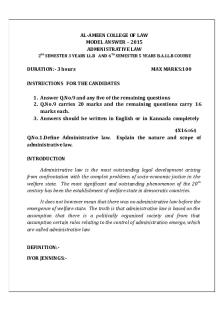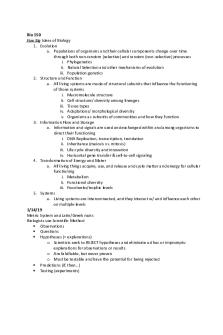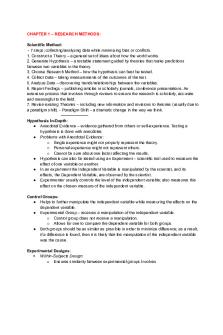Mcb 150 Exam 1 Ultimate Review - Histological Lecture Notes On Administrative Stuff PDF

| Title | Mcb 150 Exam 1 Ultimate Review - Histological Lecture Notes On Administrative Stuff |
|---|---|
| Course | Molec & Cellular Basis Of Life |
| Institution | University of Illinois at Urbana-Champaign |
| Pages | 13 |
| File Size | 220.6 KB |
| File Type | |
| Total Downloads | 43 |
| Total Views | 119 |
Summary
Download Mcb 150 Exam 1 Ultimate Review - Histological Lecture Notes On Administrative Stuff PDF
Description
Lecture 1 Admin stuf Lecture 2 1700s Carl Linnaues
Genus species naming system Taxonomy
2 types of cells:
Eukaryotes o Has a nucleus o Animal cell o Plant cells have cell walls and chloroplasts o Plasma membrane-separates cell from extracellular space o Organelles are compartmentalized o Mitochondria o Nucleus Has a nuclear envelope Double membrane o Lysosome o ER Smooth rough o golgi Prokaryotes o Does not have a nucleus o Have a cell wall- usually, but not always present o Plasma membrane-every cell has to have a plasma membrane o Cytoplasm inside the cell o Nucleoid region-not separated by a membrane Just hanging out in the cytoplasm Where genetic material is found Usually a single chromosome Domains of Life o Until 1977- superkingdoms Prokaryotes w/o nuclear membrane and membrane bound organelles eukaryotes w/ a nuclear membrane and membrane bound organelles o Carl Woese- UIUC Compared small subunit rRNAs Essential in every organism
Closer the rRNAs, the closer they are related Why rRNA? Evolutionarily ancient Found in all organisms Have the same function in all organism Highly conserved o Evolved slowly o Any changes are very important Conclusion Prokaryotes are 2 distinct groups of organisms o Bacteria- true bacteria like E. coli Found everywhere o Archaea “ancient” prokaryotes Found in extreme habitats Extreme heat, pressure, acids, salts, gases Archaea more closely related to eukaryotes than to bacteria New TREE OF LIFE o 3 DOMAINS Bacteria + archaea No nuclear membrane No membrane bound organelles Typically 1-10 microns 1 chromosome o Mostly circular Eurkarya Nuclear membrane Has organelles 10-100 microns More than 1 chromosome Linear chromosomes
Intro to Cells o Cells need to be compartmentalized o Life is composed of cells o Basic tenets of cell theory Cell is fundamental unit of life All organisms are composed of one or more cells All cells come from pre-existing cells o Why are cells so small? As the size increases, the SA to V ratio decreases Need SA for difusion Need V for storage Large enough to sustain metabolism But might be less efficient
o
o
Relative Size Cells are about 100-10 micrometers Scale of life!!!!!!! Microscopy Light microscope Good for seeing cells and some other subcellular stuf Electron microscopy TEM SEM o More 3-D perspective Darker images= dense material
Basic Bacterial Structure
Some cells (plants, most prokaryotes) have a rigid cell wall o Providing shape and protection Every cell is surrounded by a plasma membrane o Allows cells to maintain a constant internal environment o Place where signals are received or sent o Acts as a selectively permeable barriers Outside layer is capsule layer o Thick mucusy layer of complex carbs and proteins o Gives cell extra layer of protection o Allow it to stick to other stuf o Not every bacterial cell has a capsule o Can sometimes be removed o Non-essential, but might have advantage if it has it Next is the cell wall Next is plasma membrane Inside is cytoplasm o In the cytoplasm, there are ribosomes o Also has nucleoid Contain DNA
Lecture 3 Basic Structure of the Eukaryotic Cell; Intro to Carbs
Plasma membrane o About 15nm wide Nucleus o About 10 microns in diameter Mitochondria Rough ER Smooth ER Golgi Apparatus
Ribosomes o Polyribosomes 4 types of biological macromolecules o Protiens o Nucleic acids o Carbohydrates o Lipids Cell composition o 70% water o 26% macromolecules o Rest other stuf Macromolecule composition o Proteins o Nucleic acids o Carbs o Lipids Macromolecules are made up of monomers o Proteins-amino acids o Nucleic acids- nucleotides o Polysaccharides- monosaccharides o Lipids- fatty acids o Polymerization- bonding together of monomers Condensation- dehydration synthesis o Release water o Release energy Hydrolysis o Use a water molecule o Input energy to break the bond o Delta G < 0 negative o Exergonic o Catabolic o Spontaneous o Energy of products is less than energy of reactants
Lecture 4 Carbohydrates
Uses: o
Energy sources, structural roles like insect exoskeletons and cell walls or cell identification and recognition General formula CnH2nOn with a backbone of H-C-OH
o o o
some monosaccharides have identical formulas but diferent structures- isomers o aldose vs. ketose
Aldose Glucose Galactose o Ketose Fructose Other monosaccharides have similar formulas and structures, but not related functions o Deoxyribose vs. ribose Trioses o 3-carbon sugar Aldose- glyceraldehyde Ketose- dihydroxyacetone Pentoses o 5-carbon sugar o
Monosaccharides are typically found with 3,5, or 6 carbons Circularization of glucose
Aldose- ribose, deoxyribose Ketone- xylulose When 2 monosaccharides come together, they form a glycosidic linkage 4 most common disaccharides o Lactose Glucose + galactose o Maltose 2 alpha glucoses o Cellobiose Beta glucose + another glucose o Sucrose Glucose + fructose Whenever disaccharides form, 1 water molecule is taken out Carbs can be modified o Can link to other molecules When covalently linked to membrane proteins or lipids, carbs act as identification and recognition molecules (chemical markers) Blood typing Glycoprotein Glycolipid o Addition of chemical groups Ex) glucose glucosamine Polysaccharides serve as chemical sources of energy or structural compounds o Cellulose o Starch o Glycogen Cellulose o Most abundant organic compound on earth o Found in plant cell walls o Linear, unbranched polymer of glucose o H-bonds are important o Linked by beta 1,4 glycosidic linkages o Structure o Monomers are beta glucose molecules Starch o Found in deez nuts, roots and stems of plant o Energy storage in plants o Helical o Unbranched or loosely branched polymers if glucose o Monomers in chain linked w/ alpha 1,4 glycosidic linkages o Chains connected w/ alpha 1,6 glycosidic linkages o Monomers are alpha glucoses Glycogen
o o o o
Energy storage in animals Helical, highly branched Same linkages as starch Monomers are alpha glucoses
Lecture 5 Proteins
We are the product of our proteins and protein activity Study of proteins- proteomics Most of the dry weight in cells Uses of proteins o Movement Actin/myosin in muscles o Defense Antibodies o Structure Keratin o Transport Hemoglobin o Signaling Glucagon o Catalysis/regulation/metabolism Amino acids are the monomers o Basic structure
Central carbon Amino- N terminus Carboxyl- C terminus R group is the only part that difers between amino acids R group- side chain o Covalent bonds are called peptide bonds Ribosomes link amino acids by joining the NH3 + group with the COO- group Always in the NC direction o Protein- polypeptide with a purpose Amino acids
20 diferent amino acids R- groups grouped by charge (4 groups) Uncharged, but polar All have an oxygen o Which makes it polar Uncharged and non-polar (hydrophobic) All are either carbon or hydrogen o No big change in electronegativity Positively charged (basic) Proton acceptor Negatively charged (acidic) Proton donor Primary and Secondary structures o Primary structure Linear sequence of amino acids N C All proteins have a unique primary structure o Secondary structure First level of folding Stabilized by H-bonds between peptide backbone linkages Because peptide backbone is polar o N-H bond is partially + o C=O is partially – o These two form H-bonds between the backbones Independent of R-groups o Found in most proteins 2 basic structures Alpha helix Beta pleated sheet o Arrows point toward the C terminus of the primary structure Prions Misfolded proteins which somehow induce normal versions of that protein to fold the same (incorrect) way Causes many diseases o Tertiary Structure Can sometimes be final conformation for some proteins Due to interactions between R-groups with each other and w/ backbone H-bonds- between polar side chains H-bonds between hydrophilic side chains and backbone Ionic bond between an acidic and a basic amino acid Hydrophobic clustering of non-polar side chains Van der Waals forces Disulfide linkages o Can only be between cysteines o o
o Only made by an enzyme Quaternary Structure Found in proteins w/ multiple polypeptide chains (subunits) Subunits can be same or diferent Relative strengths of stabilizing forces o Disulfide linkages- only covalent bonds o Ionic bonds- easily made and broken o Hydrogen bonds o Hydrophobic clusters o Van der waals forces o
Lecture 6 Denaturation and Enzymes
Denature- removal or inactivation of stabilizing forces which unfolds the protein to primary structure o No peptide bonds are broken o All of secondary and tertiary structure is lost o Leads to loss of function o Caused by acids/bases, heat, detergents Most proteins are enzymes o Biological catalysts Facilitate reactions Reactions that require energy are biosynthetic or anabolic o Condensation reactions Reactions that release energy are catabolic o Spontaneous o Hydrolysis reaction Energy diagrams o Energy of activation o Conversion of substrates into transition states and then products Delta G= free energy of reaction: o Diference in E between reactants and products Enzymes do not cause reactions which would normally not occur o Only speed up reactions Enzymes bind substrates w/ high specificity into their active sites o They will cause some change in substrate, but they usually change shape upon binding substrate Induced fit How does substrate binding to act o Acting as a template for substrate orientation o Stressing the substrates and stabilizing the transition state o Providing a favorable microenvironment o Participating directly in the catalytic reaction Enzymes are unchanged by the reactions they catalyze
Enzymes do not change equilibrium o Only make reaching eq faster o Decrease Ea by the same amount in both directions of the reaction
Lecture 7 enzyme Optima and Inhibition; Nucleic Acids
Most enzymes tend to be near body temperature (37 degrees C) and pH (7.0) Enzyme inhibition o Irreversible inhibitors Permanently bind to or modify active substrate Changing concentration of natural substrate or inhibitor has no efect Tend to be molecules not typically encountered by that cell Exemplify that enzymes must be unchanged o Competitive inhibition Inhibitor physically resembles the natural substrate and occupies active site Enzyme can’t use inhibitor as substrate- no products are formed Can be “flooded out” by increasing concentration of natural substrate Decreasing concentration of inhibitor also reduces probability of inhibitor finding active site Ex) ethanol o Noncompetitive inhibition Inhibitor molecule binds to the enzyme in a place other than the active site Increasing substrate concentration has no efect Reversible because inhibitor can become unbound
Nucleic Acids
DNA RNA Information storage role in a cell Monomers of nucleic acids are nucleotides Phosphate-sugar-base
Base + sugar = nucleoside Pyrimidines o Cytoside o Thymine-DNA
o Uracil-RNA Purines o Adenine o Guanine
Lecture 8 Nucleic Acids; Lipids and Biomembranes
Nts of DNA and RNA difer in 2 important ways o The nitrogenous bases found in each nucleic acid o Which 5-carbon sugar is found in each nucleic acid DNA o Deoxyribose sugar (H at 2’ carbon) o Pyrimidine bases are cytosine and thymine o Purine bases are adenine and guanine o Monomers are called dNTPs o Double-stranded RNA o Ribose sugar (OH at 2’ carbon) o Pyrimidine bases are cytosine and uracil o Purine bases are adenine and guanine o Monomers called NTPs, ribonucleoside triphosphate, ribonucleotides o Single-stranded Polymerization of nucleic acid o Phosphodiester linkage o 3’ H connects to OH in phosphate group
Lipids
Defined by a physical property, not a chemical structure Vary widely in structure 3 primary functions o Energy storage Triglycerides o Biomembrane composition Phospholipids Glycolipids o Chemical signaling Steroids Biological membranes o Monomers Glycerol Fatty acids
3 fatty acids + glycerol = triglyceride A fat Connected with an ester linkage o 2 fatty acids + glycerol + phosphate = phospholipid Common examples of major membrane phospholipids Phosphatidic acid Phosphatidylethanolamine Phosphatidylcholine …serine …inositol Sphingomyelin o Choline Message: a lot of variety in polar head groups o Tails can vary too Phospholipids are amphipathic Phospholipids in water will spontaneously form micelles or bilayers o Bilayers have exposed edges Will fold into liposomes Some membrane lipids are glycolipids 4th type of lipids are steroids o Can be used as circulating hormones or as membrane components o Animals cells have cholesterol in their biomembranes o Plants & fungi: diferent steroids o Bacteria: none Biomembranes are asymmetrical Biomembranes have associated proteins o Serve as a variety of function Biomembranes are selective permeable o High permeability Small, nonpolar Small, uncharged polar Large, uncharged polar Ions o Low permeability o
Lecture 9
Biological membranes are fluid Experiment o Mouse and human cell Fluid- ability of molecules to move around in membranes Movement of lipids o Flex or rotation
Very rapid Lateral shif Rapid o Transverse difusion Very slow Need an enzyme Catalyzed by flipase Fluidity is temperature dependent o Lower temperature means closer to gel phase o High temperature means closer to fluid phase Other factors to increase fluidity o High level of unsaturated fatty acids More kinks in fatty acids o Shorter tail length of fatty acids Less able to interact with their neighbors o Higher number of cholesterol molecules (at low temperatures) Breaking up the interactions between the lipids o
...
Similar Free PDFs

MCB 150 Study Guide Exam 1
- 7 Pages

Administrative Law - Lecture notes 1
- 48 Pages

Administrative Law Exam Notes
- 60 Pages

Exam 1 review - Lecture notes 1
- 9 Pages

Exam 1 Review - Lecture notes 1-6
- 22 Pages

Bio 150 - Lecture notes 1-7
- 5 Pages
Popular Institutions
- Tinajero National High School - Annex
- Politeknik Caltex Riau
- Yokohama City University
- SGT University
- University of Al-Qadisiyah
- Divine Word College of Vigan
- Techniek College Rotterdam
- Universidade de Santiago
- Universiti Teknologi MARA Cawangan Johor Kampus Pasir Gudang
- Poltekkes Kemenkes Yogyakarta
- Baguio City National High School
- Colegio san marcos
- preparatoria uno
- Centro de Bachillerato Tecnológico Industrial y de Servicios No. 107
- Dalian Maritime University
- Quang Trung Secondary School
- Colegio Tecnológico en Informática
- Corporación Regional de Educación Superior
- Grupo CEDVA
- Dar Al Uloom University
- Centro de Estudios Preuniversitarios de la Universidad Nacional de Ingeniería
- 上智大学
- Aakash International School, Nuna Majara
- San Felipe Neri Catholic School
- Kang Chiao International School - New Taipei City
- Misamis Occidental National High School
- Institución Educativa Escuela Normal Juan Ladrilleros
- Kolehiyo ng Pantukan
- Batanes State College
- Instituto Continental
- Sekolah Menengah Kejuruan Kesehatan Kaltara (Tarakan)
- Colegio de La Inmaculada Concepcion - Cebu









